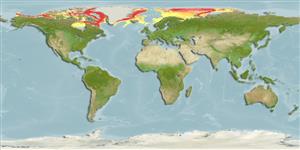Environment: milieu / climate zone / depth range / distribution range
экология
морской батидемерсальный; пределы глубины 50 - 1400 m (Ref. 117245). Deep-water; 80°N - 58°N, 161°W - 104°E (Ref. 117245)
Northeast Atlantic: eastern central Greenland southeast to just north of the Faroes, Jan Mayen Island, around Spitsbergen and northern parts of Barents Sea. Arctic: Franklin Bay, North Western Territory and Alaska (Ref. 11976); also the Kara and Beaufort seas.
Size / Вес / Возраст
Maturity: Lm ? range ? - ? cm
Max length : 51.7 cm TL самец/пол неопределен; (Ref. 11976)
Краткое описание
определительные ключи | морфология | морфометрия
позвонки: 96. Pelvic fins small (Ref. 4695). Uniformly or mostly dark, with 5-8 short, light cross-bands; band across nape, if present, straight, not curved forward; peritoneum dark, with dense brownish-black dots (Ref. 4695).
Found on muddy bottoms (Ref. 4695). Benthic (Ref. 58426). Feeds mainly on epibenthic animals. With increase in size, shrimps and euphausiids are ingested in greater quantities but unlike L. reticulatus, its ingestion of smaller prey items does not decrease. Changes in feeding habit with size are relatively small (Ref. 13532).
Life cycle and mating behavior
Maturities | размножение | Spawnings | Egg(s) | Fecundities | личинки
McAllister, D.E., M.E. Anderson and J.G. Hunter, 1981. Deep-water eelpouts, Zoarcidae, from Arctic Canada and Alaska. Can. J. Fish. Aquat. Sci. 38(7):821-839. (Ref. 11976)
Статус Красного Списка МСОП (Ref. 130435)
Угроза для людей
Harmless
Использование человеком
дополнительная информация
инструменты
Специальные отчеты
Скачать в формате XML
ресурсы в Интернет
Estimates based on models
Preferred temperature (Ref.
123201): -0.7 - 2.6, mean 0.4 °C (based on 489 cells).
Phylogenetic diversity index (Ref.
82804): PD
50 = 0.5000 [Uniqueness, from 0.5 = low to 2.0 = high].
Bayesian length-weight: a=0.00275 (0.00171 - 0.00444), b=3.20 (3.06 - 3.34), in cm total length, based on LWR estimates for this species & Genus-body shape (Ref.
93245).
Trophic level (Ref.
69278): 3.4 ±0.44 se; based on food items.
устойчивость к внешним воздействиям (Ref.
120179): очень низкий, минимальное время удвоения популяции более 14 лет (Preliminary K or Fecundity.).
Fishing Vulnerability (Ref.
59153): Moderate vulnerability (41 of 100).
